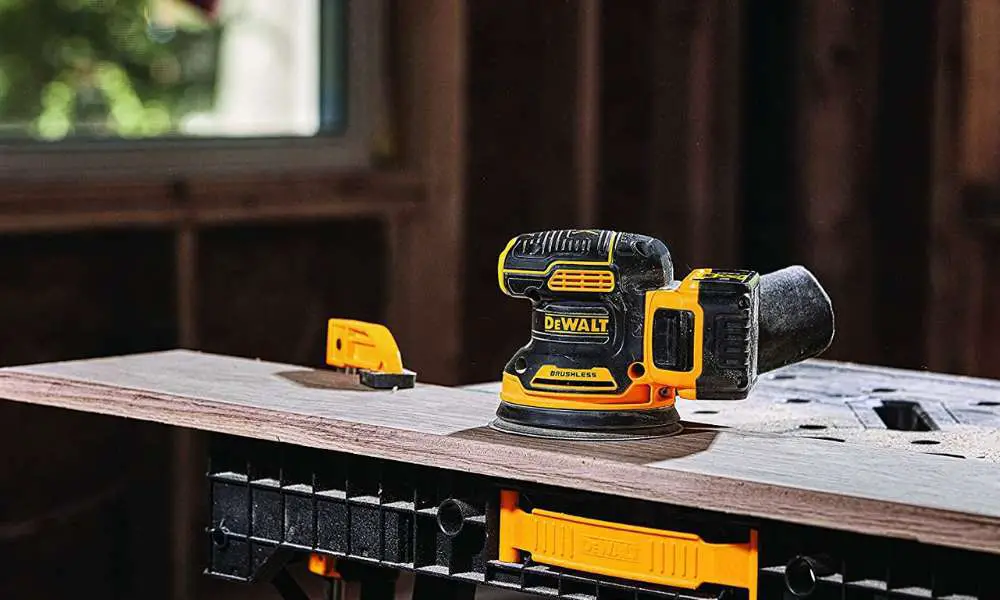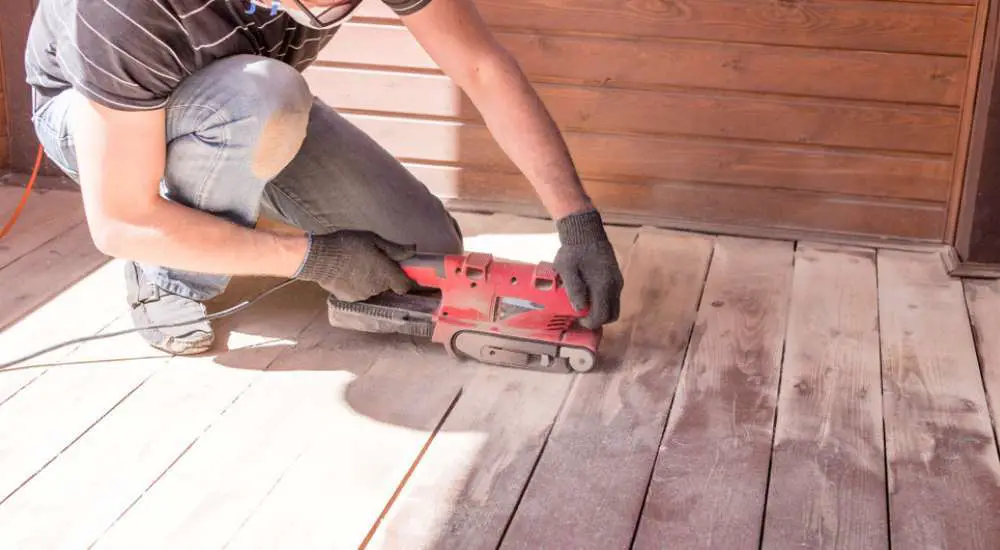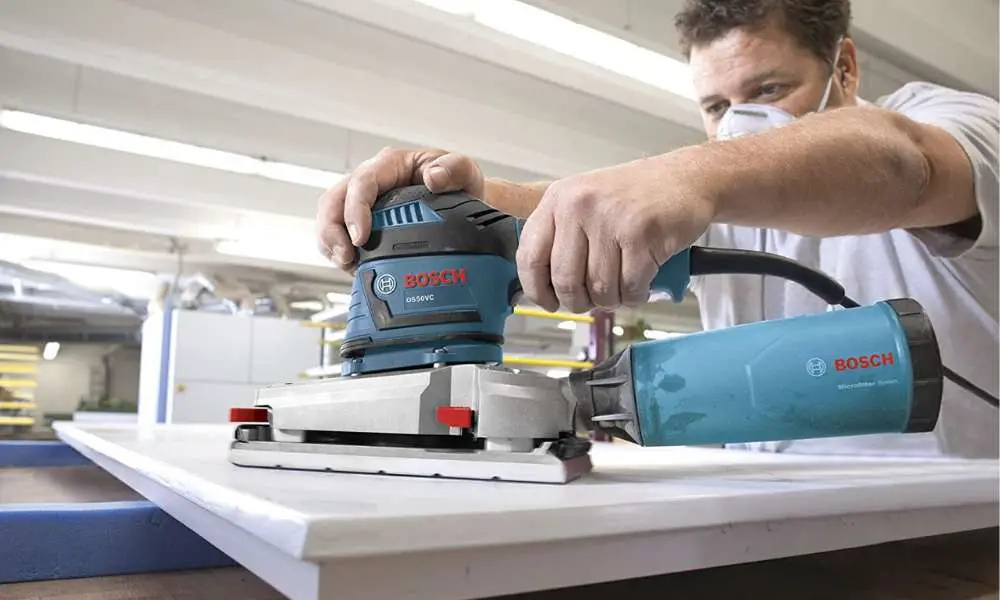A random orbital sander is a popular power tool used in various woodworking and refinishing projects. Known for its efficiency and versatility, this hand-held device operates in a random-orbit motion, providing constant irregular overlapping circles, resulting in a smoother finish with minimal visible scratches. This tool was first commercially utilized in 1968 by Rupes Tools and has since become an essential piece of equipment in many workshops.
These sanders come equipped with several key components that contribute to their effectiveness, including a powerful motor, variable speed controls, and circular or square sanding pads with built-in dust collection systems. The random orbit motion is achieved by the combination of a spinning sanding disc and the eccentric motion of the disc’s center axis, allowing for a smoother finish when compared to a standard orbital sander.
When using a random orbital sander, it is important to select the appropriate type and grit size of the sanding pad depending on the project at hand. It is also essential to maintain a safe operating environment and practice proper safety and maintenance procedures to ensure both the longevity of the tool and the user’s well-being.
Contents
- 1 Definition and Basics
- 2 Key Components
- 3 Operating a Random Orbital Sander
- 4 Applications and Materials
- 5 Safety and Maintenance
- 6 Selecting a Random Orbital Sander
- 7 Frequently Asked Questions
- 7.1 How does a random orbital sander differ from a traditional orbital sander?
- 7.2 What are the primary uses of a random orbital sander?
- 7.3 What distinguishes a random orbital sander from a disc sander?
- 7.4 Can you outline the disadvantages of using a random orbital sander?
- 7.5 What safety precautions should be taken when operating a random orbital sander?
- 7.6 What factors should be considered when reviewing different random orbital sanders?
Key Takeaways
- Random orbital sanders provide smoother finishes with minimal visible scratches due to their specific random-orbit motion.
- Key components like the motor, speed controls, and sanding pads contribute to the effectiveness of random orbital sanders.
- Proper safety, maintenance, and sanding pad selection play essential roles in the efficiency and longevity of the tool.
Definition and Basics
What Is a Random Orbital Sander?

A random orbital sander is a hand-held power tool used primarily for finishing woodworking pieces. It uses a random orbit action, which means the sander moves in constant irregular overlapping circles, providing a smoother and more consistent finish source. This tool is commonly found in DIY workshops and serves a variety of purposes, from smoothing surfaces to stripping paint and stain sources.
Some key features of a random orbital sander include:
- Size: Compact and designed for single-handed use
- Power source: Either corded or cordless (battery-powered)
- Disc size: Common sizes range from 5 to 6 inches in diameter
- Variable speed: Allows users to control the speed of the sander for different applications
How It Differs from Other Sanders
The random orbital sander is often compared with the orbital sander, but these are two distinct tools. The most notable difference between them is their respective motions. While the random orbital sander uses a random-orbit action, the orbital sander employs a square, back-and-forth movement source. This difference in motion results in the random orbital sander producing a more uniform and less aggressive finish, reducing the risk of visible swirl marks.
Here is a brief comparison between the random orbital sander and the orbital sander:
| Feature | Random Orbital Sander | Orbital Sander |
|---|---|---|
| Shape | Round pad | Square pad |
| Motion | Random orbit action | Back-and-forth movement |
| Finish | Smooth, uniform | More aggressive, can leave visible marks |
In contrast to a palm sander, which is another type of finishing sander, the random orbital sander typically provides a higher-quality finish. A palm sander, also known as a sheet sander, frequently uses a square or rectangular sanding surface and moves in a straight back-and-forth motion source. This tool might be more affordable than a random orbital sander, but it generally offers less versatility and a lower-quality finish.
Key Components
Motor and Power Source
The random orbital sander is driven by a high-torque AC motor that powers the tool, allowing it to efficiently perform sanding tasks. These power tools can have varying motor sizes, which directly relate to the tool’s application and performance. Some models are corded, requiring constant access to a power outlet, while others are cordless, providing greater mobility by functioning on rechargeable batteries.
Sanding Pad
The sanding pad is arguably the most critical component of a random orbital sander. It is a round pad featuring a Velcro or adhesive surface that holds the heavy-duty sandpaper and is connected directly to the motor. The pad moves in a random orbit, which results in overlapping circular motions that prevent swirl marks on the sanded surface. Sanding pads are available in different sizes and materials, allowing the user to adapt the tool to specific material types and project requirements.
Dust Collection System
Since sanding projects tend to create plenty of dust, a random orbital sander features a built-in dust collection system to help maintain a clean and safe environment. This system primarily consists of a dust extraction port and a vacuum hose or filter bag attachment. While operating the tool, the dust collection system effectively captures and contains dust particles, preventing them from spreading in the workspace and posing potential health hazards. Some models may even feature advanced HEPA filters for even better filtration of harmful particles.
Operating a Random Orbital Sander
Preparation Steps
Before using a random orbital sander, ensure you have taken the necessary preparation steps.
- Dress for the job: Wear proper gear, including safety goggles and a dust mask to prevent irritation due to the dust generated during sanding. In some cases, wearing gloves can be beneficial for extra grip and protection (source).
- Select appropriate sandpaper: Choose sandpaper with the right grit size based on the task. Begin with a coarser grit for removing material and gradually switch to finer grits to achieve a smoother finish.
- Attach the sandpaper: Align the sandpaper with the sander’s backing pad and fasten it securely. Random orbital sanders usually have hook-and-loop or adhesive attachments.
- Prepare the workpiece: Ensure the workpiece is clean and stable. If necessary, use clamps to secure it to a workbench.
Sanding Technique
When operating a random orbital sander, consider the following tips to achieve the best results:
- Start the sander before touching the workpiece: Power on the sander and let it reach its full speed before making contact with the material (source).
- Use a slow, steady motion: Move the sander in small orbits and random patterns to prevent swirls, scratches, and marks on your workpiece (source). Avoid applying excessive pressure as it may cause uneven sanding and shorten the life of the sandpaper. Let the sander do the work for you.
- Overlap your passes: As you progress with your sanding, make sure to slightly overlap each pass to prevent uneven spots and ensure a consistent finish.
Applications and Materials
In this section, we will explore the suitable materials for sanding and typical applications of random orbital sanders.
Suitable Materials for Sanding
Random orbital sanders are versatile tools that can be used on a variety of materials. Some of the most common materials they work well with include:
- Wood: Softwoods, hardwoods, and engineered woods like plywood and MDF. Note: Exercise caution when sanding veneered materials, as sanding through the veneer is possible with excessive pressure.
- Plastic: Suitable for shaping and smoothing plastic surfaces.
- Metal: Used for removing rust, paint, or burrs from metal surfaces. Make sure to use proper sanding pads designed for metal surfaces.
- Composite materials: Random orbital sanders can also be used on composite materials, such as solid-surface countertops.
Remember to always use the appropriate sanding pad or disc for the specific material being worked on.
Typical Applications
Random orbital sanders are popular choices for a range of applications due to their ability to produce smooth finishes with minimal swirl marks. Some common applications include:
- Preparation of surfaces: They are ideal for removing old paint, varnish, and finishes from furniture, walls, and other surfaces.
- Fine finishing: Random orbital sanders can create a smooth surface for applying paint, stain, or other coatings.
- Woodworking projects: They are perfect for shaping and fixing imperfections in joinery or woodworking pieces, as well as removing dents, gouges, and scratches.
- Rust removal and metal preparation: They can be used for removing rust from metal surfaces and preparing them for painting or other treatments.
In conclusion, random orbital sanders are versatile tools that can be used on a variety of materials and for a wide range of applications. By selecting the right sanding pad or disc and following proper sanding techniques, you can achieve professional results with your random orbital sander.
Safety and Maintenance
Safety Guidelines
When using a random orbital sander, it’s important to follow a few key safety guidelines to protect yourself and others. First, always wear appropriate personal protective equipment (PPE) such as safety glasses, a dust mask, and hearing protection. This will help prevent injuries from dust, debris, and loud noises.
Before starting the sander, make sure to secure the workpiece using clamps or a vise, ensuring it won’t move during the sanding process. Keep your fingers and loose clothing away from the sanding pad when the tool is running to avoid getting caught.
While using the sander, apply gentle, even pressure to the tool, without pushing too hard, as excessive pressure can cause damage to the tool and uneven sanding results. Keep a firm grip on the sander with both hands to maintain proper control 1.
Finally, always unplug the tool when changing the sanding pad or when it’s not in use to prevent accidents.
Maintenance Tips
To ensure your random orbital sander remains in good working condition, follow these simple maintenance tips:
- Inspect the sanding pad regularly: Check for excessive wear or damage, and replace it if necessary. Using a worn or damaged pad can lead to uneven sanding results or cause damage to the tool.
- Clean dust and debris: After each use, clean dust and debris from the sander, especially around the motor and vents, to prevent buildup that could reduce the tool’s performance or lifespan 2.
- Replace sanding discs: When the sanding discs become worn or clogged, replace them promptly. Using worn discs reduces the efficiency of the sander and can cause uneven sanding results.
- Lubricate: Periodically lubricate the tool’s moving parts with a light machine oil, as recommended by the manufacturer. Proper lubrication helps to prevent friction, increasing the tool’s lifespan.
- Storage: When not in use, store the random orbital sander in a cool, dry place, away from moisture, dust, and direct sunlight. Proper storage helps to prolong the tool’s life and ensures it is ready for use whenever needed.
Selecting a Random Orbital Sander

Important Features to Consider
When choosing a random orbital sander for your projects, there are several important features to consider:
- Motor size: The power of the motor will determine the sander’s ability to handle different materials and workload. A more powerful motor is suitable for heavy-duty tasks.
- Body configuration: Random orbital sanders come in various designs such as palm-sized, right-angle, or inline models. Choose a design based on your comfort and project needs.
- Pad size: These sanders usually have 5-inch or 6-inch pads. Larger pad sizes can cover more surface area but may be harder to maneuver in tight spaces.
- Dust control: Select a model with built-in dust control to maintain a clean workspace and improve the sander’s efficiency.
| Feature | Considerations |
|---|---|
| Motor size | Power, workload, and materials |
| Body configuration | Design, comfort, and user preferences |
| Pad size | Surface area coverage, maneuverability in tight spaces |
| Dust control | Cleanliness, efficiency |
Price vs. Quality
In terms of price, random orbital sanders can range from around $50 to $200. A decent palm-sized unit typically falls between $50 and $100, while heavy-duty right-angle or inline models can cost $150 to $200 as mentioned.
However, it’s important to balance the price with quality:
- Invest in a reputable brand: Opt for a well-known brand that offers reliable products and support.
- Read customer reviews: Analyze reviews and recommendations from users to see if the sander you’re considering is worth the investment.
- Consider durability: A higher-priced sander may pay off in the long run if it is built to withstand regular use and has a longer service life.
Overall, carefully look at each feature and aspect of the random orbital sander before making a decision. Balancing price, quality, and your specific needs will lead to selecting the right sander for your projects.
Frequently Asked Questions
How does a random orbital sander differ from a traditional orbital sander?
A random orbital sander moves in small ellipses, causing the entire sander to move in an orbital fashion. In contrast, a traditional orbital sander oscillates consistently but at a slower speed, making it less aggressive and ideal for prepping surfaces before painting or staining the source. Additionally, random orbital sanders have round sanding pads, whereas traditional orbital sanders have square pad sources.
What are the primary uses of a random orbital sander?
Random orbital sanders are versatile tools, primarily used for sanding and smoothing various materials. Their unique shape enables them to work on both flat surfaces and contours source. They are often used for woodworking, metalworking, and even automotive polishing tasks.
What distinguishes a random orbital sander from a disc sander?
A random orbital sander features a circular sanding pad that moves in an orbital motion, allowing it to create a smoother finish without noticeable scratch patterns. On the other hand, a disc sander has a stationary sanding surface that spins at high speeds, making it more suitable for aggressive material removal sources.
Can you outline the disadvantages of using a random orbital sander?
Some disadvantages of using a random orbital sander include slower material removal compared to more aggressive sanders such as belts or disc sanders. Additionally, they may not be as effective for working in tight spaces, where a traditional orbital sander may be a more suitable source.
What safety precautions should be taken when operating a random orbital sander?
When operating a random orbital sander, it’s essential to wear proper gear and attire to prevent injury or irritation. This includes a mask that forms a tight seal around the nose and mouth, as these sanders generate significant amounts of dust, even with a vacuum attachment source. Protective eyewear is also a must, and it’s beneficial to use ear protection due to the noise generated by the sander.
What factors should be considered when reviewing different random orbital sanders?
When choosing a random orbital sander, consider the motor size, body configuration, and pad size (usually 5 or 6 inches) to fit your workload. Price, dust collection features, and ergonomics also play essential roles in finding the right sander for your needs source.



Leave a Reply